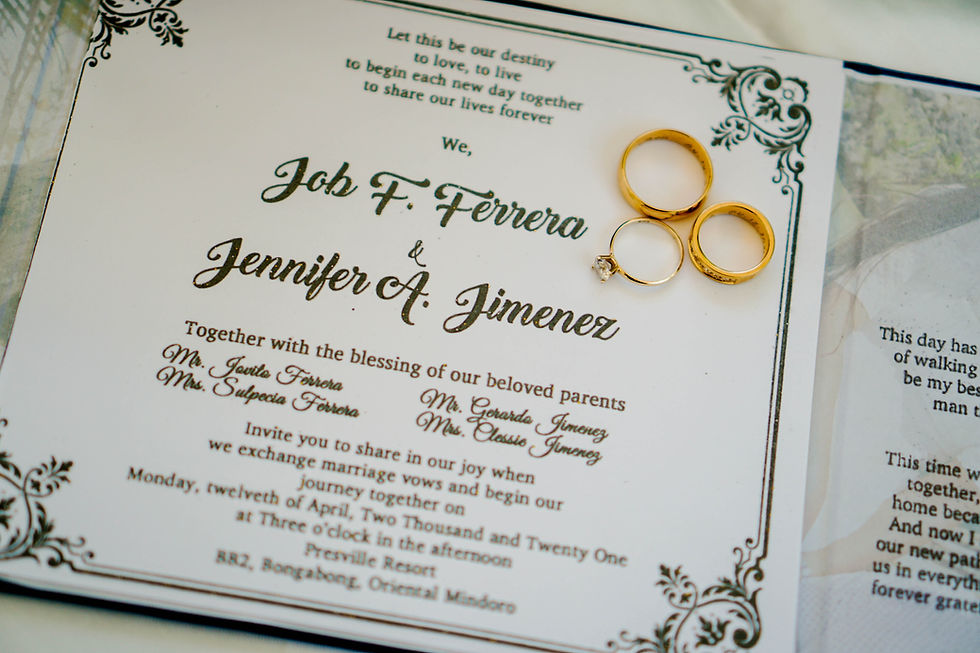Save-the-Dates vs Wedding Invitations: What's the Difference?
- Confetti & Curves
- Dec 21, 2021
- 3 min read
Some say you should send save-the-dates, while others say send wedding invitations, which should you do?
You and your partner have finally, and officially, set the wedding date. Congratulations! So, what now? Pop the champagne and kick back? Well, if you actually want people to attend your big day, there are lots of wedding planning tasks ahead. Most important of them being, inviting your guests to the celebration! And when it comes to wedding invitations, couples often get a bit confused or worried about how to go about them.

Should you send save-the-date cards or formal invitations? Or both? As with all things in the wedding world, everything is up for debate. And at the end of the day, it really depends on your preference, when and where your wedding will take place and your guest list.
To help you make an informed decision, we thought we'd break down the difference between save-the-dates vs. invitations, including their purpose, and when to send them and what to include in each.
Save the Date vs. The Wedding Invitation – Everything You Need to Know
What's the Difference Between Save the Dates & Wedding Invitations?
There is a clear difference between save the dates and wedding invitations. A Save the Date card tells your guests to do exactly that, reserve the date in their calendar. While it does give some information about when and where your wedding will be held. The real role of the save the date is to simply allow guests to plan, and also let them know that a formal invitation will be sent at a later date.
The information on your Save the date card should include the request (e.g., 'Please Save the Date'), your names, wedding date, location (wedding venue if booked, otherwise town/city will suffice). Plus a note to let them know that a formal invitation is on its way. You can also include a wedding website if you have one.
As your wedding date gets closer, you will need to send out your actual wedding invitations. This official wedding invitation will offer much more detail about your special event. This is where you will share the venue information, the date, and time of the wedding, and the date and time of the reception. Also, it's important to include any requirements on attire, or if the occasion is adults only.
You may also need to include additional wedding stationery and inserts with your wedding invitations, that provide details such as hotel information, an itinerary if you're having multiple wedding events, maps to the wedding venues, if childcare will be available, and the wedding website. Wedding gift information is traditionally kept off printed materials, but feel free to add if you feel its appropriate. Otherwise, include the info on your wedding website.

RSVPs
A key difference between a save-the-date and a wedding invitation, is that the latter include RSVPs. RSVPs allow you to get a headcount on how many guests will be attending your wedding, be it in traditional print, or via your wedding website. If you decide to go for printed RSVPs, keep in mind that your guests will need ample time to send back the RSVP card via Royal Mail, or air mail if they are living abroad.
Plus ones are typically included on the invitation envelope (e.g., Susan Smythe and guest). If your invitee has children, and you are welcoming children to your big day, then you can make that clear on the RSVP by adding the number of guests invited.
When Do You Send Save the Dates?
There's no hard and fast rule of exactly when you should send out save-the-dates. However, ideally, the sooner, the better, once you've established a wedding date. We would recommend somewhere between 6 and 12 months before your wedding date, 8 months being the optimum time.
When to Send Out Wedding Invitations?
The ideal timeframe for sending out wedding invitations, is roughly 8 to 12 weeks before the wedding date. This amount of time will give your wedding guests the opportunity to send back their RSVPs, and make any necessary bookings.

Comments